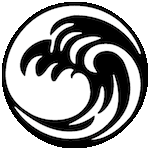Dojo Japanese 101
Translations of Japanese Language Used in Martial Arts
Compared to more traditional dojos, we don't use as much Japanese on the mats (certainly not everything that's listed below), but it can be of cultural interest to many students, and can be useful when we bring in guest instructors who use the language more. Below is a list of Japanese terms and expressions and their translations that are used in a martial arts context. At the bottom of the page there is a link to a pdf file that includes who they are written in the Japanese language (using kanji or hiragana). It contains more detailed explanation within its footnotes and is formatted for printing.
Basic Terminology:
dojo- martial arts training hall
gi (or dogi)- uniform
sensei- teacher
sempai- senior (student)
shihan- master instructor
seiza- kneeling position
mokuso- meditation
hajime- begin
yame- stop
shomen - the front wall of the dojo. Literally translated sho means 'true' while men means 'face'. It is considered a place of honour in the dojo.
rei - bow
tatte- stand up
uke- person who receives the action
tori- person who performs the action
o-tagai/tagai - mutual, reciprocal
Bowing Commands:
Shomen ni rei - Bow to front wall of dojo out of respect for the style.
Sensei ni rei - Bow out of respect for the instructor.
Otagai-ni-rei - Bow out of mutual respect for each other.
Directions:
mae- forward
ushiro- back
hidari- left
migi- right
Numbers:
ichi- one
ni- two
san- three
shi- four
go- five
roku- six
shichi- seven
hachi- eight
kyu- nine
ju- ten
Basic Techniques:
uchi- strike
tsuki- punch
geri (or keri)- kick
uke- block
nage- throw
Expressions:
Konnichiwa- Hello.
Arigato gozaimashita- Thank you. (polite version)
Onegaishimasu- I humbly request (Said at the begining of class or before training with a new partner.)
Daijobu- I'm alright. (Can also be used as a question, "Are you alright?")
O-tsukaresama deshita- Thank you for your tiredness from the effort. (Said after class)
Go-kurosama deshita- It was a great hardship; I appreciate your efforts. (Can also be said after class)
Ki o tsuke- Stand at attention.
Hai or Ee- Yes. (Many dojos also osu in the same context. Literally it means "to push.")
Chigaimasu. OR Chigau.- It's different. (This is used in place of "No.")
Mo ichido or mo ikkai- One more time.
Ki o tsukete- Be careful.
Sayonara- Good-bye.
Training Concepts:
kiai- shout
kime- focus
tanden- abdomen
zanshin- remain alert
kisoku- abdominal breathing
bunkai- application (or analysis)
mushin- no mind
seishin- spirit
Stances (tachikata):
hachiji-dachi- natural stance
zenkutsu-dachi- forward stance
kiba-dachi- horse stance
Hand Attacks (tsuki-te):
seiken- regular fist
shotei- palm heel
haisho- back hand
empi- elbow
kote- forearm
nakadakaken- middle knuckle fist
haito- inside blade hand (aka- ridge hand)
tetsui- hammer fist
Dojo Japanese 101 PDF
Basic Terminology:
dojo- martial arts training hall
gi (or dogi)- uniform
sensei- teacher
sempai- senior (student)
shihan- master instructor
seiza- kneeling position
mokuso- meditation
hajime- begin
yame- stop
shomen - the front wall of the dojo. Literally translated sho means 'true' while men means 'face'. It is considered a place of honour in the dojo.
rei - bow
tatte- stand up
uke- person who receives the action
tori- person who performs the action
o-tagai/tagai - mutual, reciprocal
Bowing Commands:
Shomen ni rei - Bow to front wall of dojo out of respect for the style.
Sensei ni rei - Bow out of respect for the instructor.
Otagai-ni-rei - Bow out of mutual respect for each other.
Directions:
mae- forward
ushiro- back
hidari- left
migi- right
Numbers:
ichi- one
ni- two
san- three
shi- four
go- five
roku- six
shichi- seven
hachi- eight
kyu- nine
ju- ten
Basic Techniques:
uchi- strike
tsuki- punch
geri (or keri)- kick
uke- block
nage- throw
Expressions:
Konnichiwa- Hello.
Arigato gozaimashita- Thank you. (polite version)
Onegaishimasu- I humbly request (Said at the begining of class or before training with a new partner.)
Daijobu- I'm alright. (Can also be used as a question, "Are you alright?")
O-tsukaresama deshita- Thank you for your tiredness from the effort. (Said after class)
Go-kurosama deshita- It was a great hardship; I appreciate your efforts. (Can also be said after class)
Ki o tsuke- Stand at attention.
Hai or Ee- Yes. (Many dojos also osu in the same context. Literally it means "to push.")
Chigaimasu. OR Chigau.- It's different. (This is used in place of "No.")
Mo ichido or mo ikkai- One more time.
Ki o tsukete- Be careful.
Sayonara- Good-bye.
Training Concepts:
kiai- shout
kime- focus
tanden- abdomen
zanshin- remain alert
kisoku- abdominal breathing
bunkai- application (or analysis)
mushin- no mind
seishin- spirit
Stances (tachikata):
hachiji-dachi- natural stance
zenkutsu-dachi- forward stance
kiba-dachi- horse stance
Hand Attacks (tsuki-te):
seiken- regular fist
shotei- palm heel
haisho- back hand
empi- elbow
kote- forearm
nakadakaken- middle knuckle fist
haito- inside blade hand (aka- ridge hand)
tetsui- hammer fist
Dojo Japanese 101 PDF
© 2012 - 2018 Empty Cup Enterprises. Pacific Wave Jiu-Jitsu is a division of Flip Side Ventures Inc.
This martial arts/self-defense school is located in Richmond BC, easily accessible from Vancouver, Delta, New Westminster, Burnaby, Ladner, Surrey, Tsawassen and White Rock.





